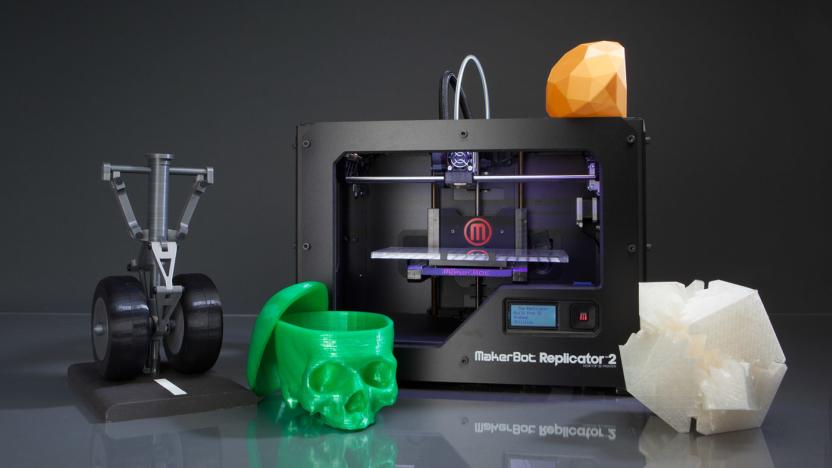PLA
Latest

Study shows some 3D printing fumes can be harmful
If you do a lot of 3D printing and are worried about the fumes, you may want to read a new study from US and French researchers. It measured the amount of particles emitted by five 3D printers using nine different filament materials. The new research builds on two previous studies, but the team tested more printers and plastics, and measured more kinds of potentially hazardous fumes. As you might suspect, they discovered that you should be 3D printing in a well-ventilated room or use an enclosed printer with a vent, particularly while printing with ABS, nylon and similar materials.

MakerBot wants you to start 3D-printing in metal and wood (sort of)
The future of 3D printing may depend on the ability print things with properties beyond cheap plastic. We've seen composite materials appear for 3D printers before, but the arrival of MakerBot to the scene should make progress a bit quicker. Announced at this week's CES, MakerBot will be rolling out new composite filaments that have been chemically bonded with new materials. You'll have to wait until late 2015, but it's probably going to be worth it: Maplewood, limestone, iron and bronze PLA composites are coming. And in real life, they look and feel far more impressive than you might think.

Oculus3D vies to be the greener solution in disposable 3D shades
As of December, RealD cinemas alone served 100 million moviegoers, and even if the vast majority recycle, that's still a ton (probably several thousand tons, in fact) of plastic 3D glasses. According to a company called Ceroplast, those glasses aren't biodegradable; if so many as 10 million pairs end up in a landfill, it would result in C02 emissions equivalent to burning 50,000 gallons of gasoline. Of course, Ceroplast wouldn't be quoting statistics if it didn't have a greener solution. Under the brand of partner Oculus3D (whose co-founder Lenny Lipton is RealD's former CTO), it's presently making biodegradable polarized shades out of polylactic acid that it intends to deploy -- along with the company's proprietary OculR projectors -- as early as summer of this year. As for which theatres you should expect to see them in, well, we're still in the dark on that one.

Hoshino debuts "biodegradable" FD-300 flash drive
It's far from the first company to attempt to make a more environmentally-friendly flash drive, but given the near disposable nature of them these days, that's not exactly a bad thing. This latest drive from Hong Kong-based Hoshino also takes a decidedly different approach than other drives that simply keep the hazardous chemicals and whatnot to a minimum, with it actually constructed out of polylactide (or PLA) made from corn that is, technically, biodegradable. The downside is that in order for it to be broken down, PLA needs to be blasted with heat for ten days on end at a specialized facility, which isn't exactly the most direct route back into the ground, or an accessible option for everybody at the moment (there's also the small matter of it being based on a food product). The drive also apparently isn't available to the general public just yet, but companies interested in doing business with Hoshino can contact 'em for more details.[Via Everything USB, background on PLA via Smithsonian Magazine]

The corntop lives: Fujitsu showing off mostly-biodegradable notebook
We're not exactly sure what became of that biodegradable laptop being touted by NEC all the way back in 2004, but the concept of corn-based notebook casings is far from dead, with Fujitsu showing off just such a machine at this year's CES. According to Inhabitat, "the main component is polylactic acid, also known as PLA, a resin that comes from the fermentation of the raw biomass from plants," although a small amount of nasty fossil fuels must still be mixed in to create a housing with the proper structural integrity. Fortunately, once the rig is ready for the great gadget heaven in the sky, the plastic can be separated from the PLA so that the latter material can be left to safely biodegrade. No word yet on when we'll see these edible inedible lappies hit the market, so for now we'll have to continue kicking Mother Nature's ass with our biannual tech upgrades.[Via, and image courtesy of, Inhabitat]


